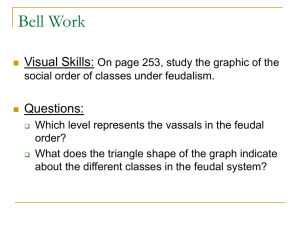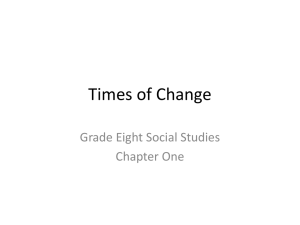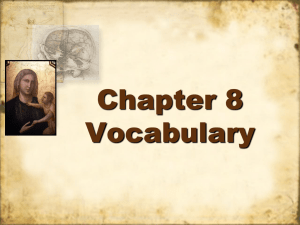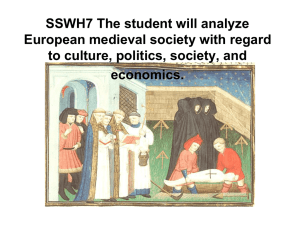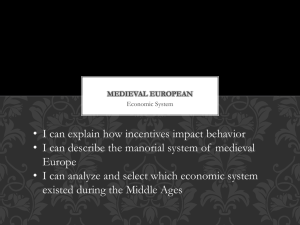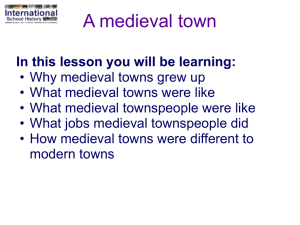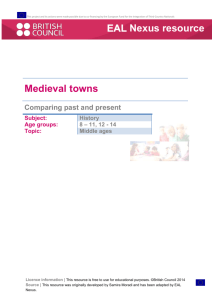Times of Change - Holy Spirit Catholic Schools
advertisement
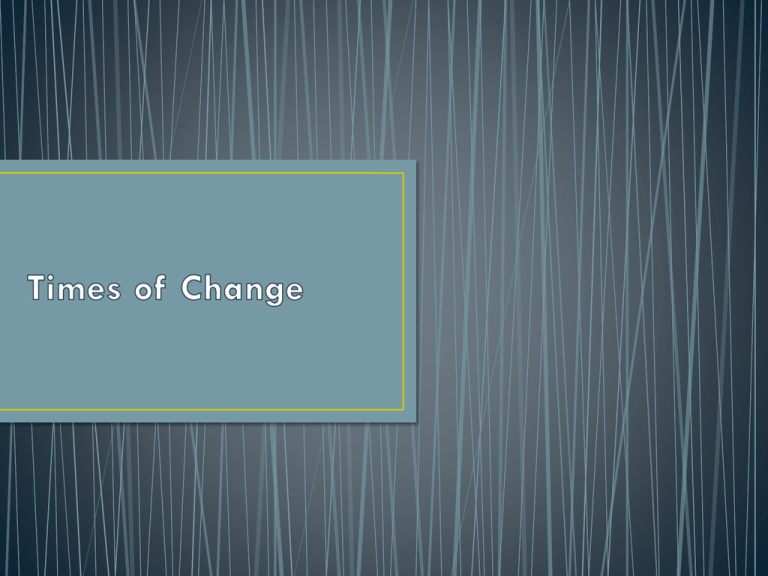
• During the Middle Ages, much of European society was organized in a system called Feudalism. • Feudalism was: • Hierarchy where people were ranked one above the other according to their importance • People were born into a level and expected to stay that level for their entire lives • Feudalism was based on land, loyalty and duty • Nobles or Knights swore oaths of allegiance to the King and promised to fight for him in exchange for land • Church owned land and therefore was very powerful and important to medieval people • • • • Large Empires break up No government rule Chaos and lawlessness happens Weaker groups band together for protection – strength in numbers • Wealthy individuals form stronger/dominant groups create forts – Have horses and weapons and control large areas of land • Outlaws and bandits prey on weaker peaceful groups – survival of the fittest • Peaceful groups turn to stronger law abiding groups for protection from the outlaws. • In return for protection, stronger individuals/groups make weaker individuals/groups sign contracts making them obligated to do certain jobs. EX. Building roads, bridges, farming … • In return the stronger groups agree to build castles and protect the weaker groups in times of need. • A political and economic system of contracts, obligations and loyalty is created. • Most people in the Middle Ages were peasants • Peasants were assigned strips of land to harvest • They lived in rural villages on a manor (piece of land) • In exchange for the use of the land, the peasants had to turn over a portion of what they produced to noble or Knight (the lord of the manor) making the peasants the lord’s vassal • They were also expected to build roads, clear forests and do other work the lord ordered • Men, women and children worked from sunrise to sunset • Peasants were illiterate and uneducated • Some peasants were Freemen – rented or worked land for pay • Most were Serfs – Not allowed to leave land • Most medieval towns were centres for farm communities • Generally close to a castle or monastery • Stone walls often were built around the town to protect it from rival cities and lords • Towns were dirty, crowded and rat-infested but they offered freedom • People had the freedom to marry who they wished and make money as they could • A peasant could open a shop and unskilled peasants could learn a trade • Production of goods and trade in towns was organized by cooperative organizations called “guilds.” • Controlled price, set standards of quality and decided who could train or apprentice • Children as young as 8 or 9 would go live with a master and learn a trade. • Rural women often had many children and shared the hard work • They also made clothes and cooked meals • In towns women would work alongside their husbands selling goods. They could inherit property and could become masters of crafts and brewing • In the families of wealthy merchants, women had more opportunities, they would be educated • Noble women had few to any rights and their marriages were often arranged for the family’s political or economic gain • How have these roles changed? • The Feudal System lasted for hundreds of years but eventually began to weaken and finally disappeared altogether • In 1337 with the start of the “Hundred Years War” between England and France peasants in both countries revolted because of high rents and taxes they had to pay to finance the war • The Black Death saw the death of millions between 1346 and 1350. Outbreaks continued for the next several hundred years. As a result severe labour shortages occurred and many feudal estates and manors went bankrupt. Nobles began to rent or sell land to serfs who were released from their obligations to the lord. • The bonds that held feudal society together eventually came undone • Peasants had some options, they could stay and work or move to the towns • As towns grew and life on the manor changed, money came into use more and people began to think of time differently • On medieval manors people activities were ruled by the sun and seasons and knowing the exact time did not matter • As shop keepers and merchants in towns became more dependent on time clocks were developed • With the rise of towns society became less rigid • By acquiring wealth and skills people had opportunity to move from one social level to another and a new social structure began to emerge • A new middle class emerged based on money rather than ownership of land and they were eager to buy goods and people became more interested in material possessions. • People in medieval times were not travellers. Most families lived in the same area for many generations. • Describe how this might affect someone’s worldview. • How do you think travelling to a new community might affect your worldview today? • How does communication technology affect someone’s worldview today? • Imagine you are a serf during the Middle Ages. Complete the following statement: “In my world… • Create three Venn Diagrams: • One that compares and contrasts rural and urban life during medieval times. • One that compares and contrasts rural life during medieval time and modern times. • On that compares and contrasts urban life during medieval times and modern times. • What happens when an epidemic like the Black Death breaks out? • We turn to medical experts and try to stop it from spreading • Scientists try to find causes and cures • Things were much different at the beginning of the Renaissance • No one knew how to treat it • Many thought the plague had been sent by God as a punishment • At this time, religion was a central part of people’s daily lives. • The worldview of the people in Western Europe was shaped by the Christian Church • Life in Medieval times was hard: sickness, famine and war were a constant threat. • As a result, the hope for a better life after death was very important • People believed that with the help of the church they would be able to reach heaven after they died. • Every group in the Church hierarchy had a duty to be obedient to the group above and provide certain services to the group below. • Priest performed religious services for members of their congregation. • Members of the congregation had a duty to obey the rules of the Church and pay him a tithe (a portion of their crops or earnings). • Bishops and citizens took great pride in their local cathedral and there was competition to see which city could produce the most beautiful building. • Many people during this time period would decide to devote their entire life to God • Men became monks and women became nuns • They spent their lives studying religious texts, praying and working for the church • What modern day examples can you give of people’s religious beliefs causing them to live a certain way? • Be positive: No answer is wrong • Be prolific: Try to generate as many ideas as possible • Monks and nuns were well educated. • Eventually universities grew up around religious schools. Unfortunately women were not allowed to attend university until the late 1800s • The other two major religions on Medieval Europe were Islam and Judaism • The Muslims conquered Spain and Portugal in the 700s and built over 700 mosques and Islamic Spain became a centre for medieval learning • Jews lived in towns of both Islamic and Christian Europe • Often forced to live in ghettos and were barred from many professions • As a result ended up becoming jewellers, money traders and merchants. • People also began to take a more critical attitude towards the church • The church was wealthy and owned 1/3 of the land and also collected money in tithes • The Black Death made people questions their faith • Their prayers and visit's to holy sites had not worked and many felt God had abandoned them • Society was changing • The emergence of busy towns and a merchant class meant society was less rigidly organized and worldly pleasure were becoming more important • A period of great creativity in the arts and sciences was about to begin • In 1855 the term “Renaissance” was coined to describe what generations thought of as the rebirth of classical knowledge and learning.


